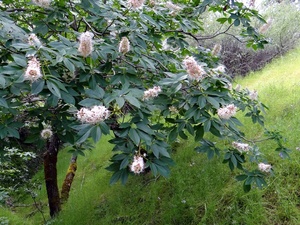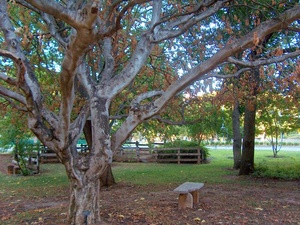 California Buckeye (Aesculus californica) blooming at Lake Berryessa in May 2016. Photo by queerbychoice.Buckeye Trees (Aesculus sp.) are members of the same plant family (the soapberry family, Sapindaceae) as maple trees. Like maple trees, they are noted for their beauty. They can also be called "horse chestnuts"; however, they are not closely related to true chestnuts, which belong to the same plant family as oak trees.
California Buckeye (Aesculus californica) blooming at Lake Berryessa in May 2016. Photo by queerbychoice.Buckeye Trees (Aesculus sp.) are members of the same plant family (the soapberry family, Sapindaceae) as maple trees. Like maple trees, they are noted for their beauty. They can also be called "horse chestnuts"; however, they are not closely related to true chestnuts, which belong to the same plant family as oak trees.
The California Buckeye (Aesculus californica) is the only buckeye species native to California, and it is native only within California's borders. The Calscape map of its native range shows that its native range includes all parts of Yolo County. Many California buckeye trees are planted along Highway 113 between Woodland and Davis.
 California Buckeye (Aesculus californica) at the Sac State Arboretum going summer-deciduous in July 2007. Photo by queerbychoice.California buckeye trees can grow as much as 40 feet tall and wide; however, depending on their environmental conditions, they quite often stay under 15 feet tall and wide. They are usually multi-trunked and at least as wide as they are tall. In spring, they cover themselves in large flower clusters that can stop traffic. The flowers are usually white, but some cultivars are available that have pink flowers. California buckeye nectar is toxic to non-native European honeybees but poses no danger to native bee species and is an important food source for many butterflies. By July, most California buckeyes begin going deciduous as an adaptation to survive summer drought. Their leaves turn brown early in summer but usually remain on the tree for several more months to help protect the bark from sunburn. When the leaves do drop, they reveal more of the trees' eye-catching pale gray bark and twisting branches. The trees remain leafless through fall and winter until the following spring.
California Buckeye (Aesculus californica) at the Sac State Arboretum going summer-deciduous in July 2007. Photo by queerbychoice.California buckeye trees can grow as much as 40 feet tall and wide; however, depending on their environmental conditions, they quite often stay under 15 feet tall and wide. They are usually multi-trunked and at least as wide as they are tall. In spring, they cover themselves in large flower clusters that can stop traffic. The flowers are usually white, but some cultivars are available that have pink flowers. California buckeye nectar is toxic to non-native European honeybees but poses no danger to native bee species and is an important food source for many butterflies. By July, most California buckeyes begin going deciduous as an adaptation to survive summer drought. Their leaves turn brown early in summer but usually remain on the tree for several more months to help protect the bark from sunburn. When the leaves do drop, they reveal more of the trees' eye-catching pale gray bark and twisting branches. The trees remain leafless through fall and winter until the following spring.
California buckeye trees prefer full sun to partial shade and average to poorly drained soil. In West Sacramento, they do not not need to be watered once established, but they can retain their leaves a bit longer with a small amount of irrigation.


